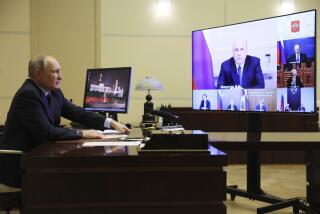Yes, a Test-Ban Pact Would Have a Price
- Share via
Because the United States needs another nuclear test about as much as Imelda Marcos needs another pair of shoes, the Reagan Administration is seeking public justification for its failure to halt nuclear weapons testing.
Administration officials can no longer credibly argue that the obstacle to a test ban is verification. The Soviets have offered to accept on-site inspections and seismic “black boxes” capable of monitoring test yields down to the one-kiloton level--far below what is needed to develop new strategic warheads.
Therefore the Administration has shifted gears, now arguing that the United States has to continue testing as long as it relies on nuclear weapons for deterrence. Until “Star Wars” fulfills the President’s dream of making nuclear weapons obsolete, it is argued, a test ban would harm our security by making existing nuclear stockpiles unreliable, which in turn would increase both “vertical” and “horizontal” proliferation.
The new argument is flawed on several grounds. First, it assumes that it would be impossible to ensure the fundamental reliability of our nuclear weapons through a program of non-nuclear testing, stockpile inspection and remanufacturing new warheads using the original specifications of existing, thoroughly tested warheads. The Administration has presented no credible evidence that this is so, and experts such as Richard L. Garwin, longtime Pentagon consultant and IBM physicist, argue that explosive “reliability” tests are unnecessary.
Nor has the Administration made a convincing case for its broader argument that a comprehensive test ban would result in a less secure world in which the growth of the superpowers’ nuclear arsenals--”vertical proliferation”--would increase. Even without the Administration’s long-promised “deep reductions,” vertical proliferation under a test ban could be avoided by agreeing to maintain the SALT II numerical limits on strategic forces. Without additional missiles and bombers, building more “unreliable” warheads has little military value.
Moreover, even under the assumption that warhead reliability degrades under a test ban, there is little reason to believe that the result would be a less secure world. The assurance that every warhead will perform at its rated yield 20 years from now might require continued explosive testing, but such levels of confidence are needed only for a first strike, which requires very accurate missiles armed with warheads of sufficient explosive power to destroy military targets. Since we assume that the Soviets may have first strike intent, but the United States does not, continued testing would help them more than it would help us.
A bizarre corollary of the Administration’s reliability argument is its Orwellian suggestion that a test ban would encourage the “horizontal” proliferation of nuclear weapons around the world. While other nations view a test ban as the sine qua non of the superpowers’ commitment to meet their disarmament obligations under the Nuclear Non-Proliferation Treaty, the Reagan Administration argues that signing a test ban may lead to proliferation by decreasing other nations’ confidence in the reliability and hence the “credibility” of the U.S. deterrent.
The Administration makes this argument while admitting that none of our allies have indicated that they would build independent nuclear forces if we signed a test ban treaty. Indeed, our allies have long stressed their support for such a treaty as a positive non-proliferation measure.
A test ban has long been advocated by the states that pose the greatest concern for future proliferation--India, Pakistan, South Africa, Argentina, Brazil and Israel. None of these nations has signed the Nuclear Non-Proliferation Treaty, which would require them to forgo the nuclear option and accept on-site inspection of their nuclear facilities while the nuclear weapons states continue testing and deploying new warheads. A test ban treaty would demand real sacrifices from the nuclear weapons states, thereby putting tremendous international pressure on the “threshold” states to forgo the nuclear option, agree to stop testing and join the non-proliferation regime.
In reality, the new arguments against the test ban are no more compelling than the verification arguments that they have replaced. Both serve as rhetorical covers for a policy that assumes that new weapons technologies are the best solutions to our security problems. When the fig leaf is peeled away, we find a commitment to keep on testing and a belief that the United States must develop every new weapons concept.
It need not be so. We have the capacity to choose our future, and we can agree to forgo pernicious technological developments. A comprehensive test-ban treaty would shut off a whole range of potential Soviet threats to our society. But it has a price: We would have to agree to halt a whole range of activities that can threaten Soviet security.
What is missing from all of the Reagan Administration’s arguments against a test ban is a lucid explanation of why it would not be a good deal.
More to Read
Get the L.A. Times Politics newsletter
Deeply reported insights into legislation, politics and policy from Sacramento, Washington and beyond. In your inbox twice per week.
You may occasionally receive promotional content from the Los Angeles Times.










